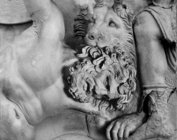Lonnie van Brummelen & Siebren de Haan
dal 10/12/2008 al 30/1/2009
Segnalato da
10/12/2008
Lonnie van Brummelen & Siebren de Haan
Project Arts Centre, Dublin
Monument to Another Man's Fatherland. The 2 collaborating Dutch artists followed a trail of migrating Celts to Berlin, where a victory monument commemorates a battle of this ancient people. The artists' 35mm black and white film slowly follows the surface of the monument's frieze. This filmic exploration of its sculptural reliefs brings us into an intimate encounter with a global treasure. The frieze depicts the gigantomachy, or struggle between gods and giants.

Curated by Tessa Giblin
Project Arts Centre is proud to present the newly commissioned installation of two films by Lonnie van Brummelen & Siebren de Haan, in the exhibition Monument to Another Man's Fatherland.
Triggered by the invitation to make a new work for Dublin, the two collaborating Dutch artists followed a trail of migrating Celts to Berlin, where a victory monument commemorates a battle of this ancient people. The artists' 35mm black and white film slowly follows the surface of the monument's frieze. This filmic exploration of its sculptural reliefs brings us into an intimate encounter with a global treasure. The frieze depicts the gigantomachy, or struggle between gods and giants. But it is also the receptacle of another tale - that of imperialism, cultural looting and the re-appropriation of national treasures, cultural heritage and the spoils of war.
Currently housed in the Pergamonmuseum on Museum Island in Berlin, this monument was removed at end of the 19th century from its site of origin nearby Bergama, Turkey. Here Celts - or Galatians, as they were called in Asia minor - battled in Pre-Roman times against the Pergamon Kingdom, a powerful but short-lived empire. To celebrate their victory, the Pergamese erected the monument to the fatherland on a mountaintop overlooking the site of the battle.
"We want to unravel the modern concept of 'universal culture' to trace how this concept relates to the current sweeping forces of globalisation. Today, it has become customary that people and objects are relocated, removed from their cultural, historical and political contexts, and distributed over the globe. Also as artists we experience this kind of transnationalism. In response to our 'drifting studio practice', we want to produce a film work, which reflects upon this contemporary condition of displacement from a historical perspective."
(The artists in a letter requesting permission for film recording.)
Initially they planned to film the sculptural battle scene in the Berlin Museum, however the Stiftung Preussischer Kulturbesitz (Foundation for Prussian Possession of Cultur), which is the current owner of the physical monument and also of the less concrete copyright, did not want to collaborate with an art project addressing the fact that the monument originates from somewhere else. This might 'stir the debate about repatriation', something the museum was 'not interested in'. The museum director's formal letter of rejection states: '… the project does not fit with our intentions from several points of view and would rather create much work and debates which we would like to avoid.' The artists were not allowed to film in the museum, nor make use of the image archive of the Stiftung Preussischer Kulturbesitz.
Numerous images of Pergamon's Gigantomachia frieze circulate in academic books and guides that have been published throughout the years. The reproductions have varying qualities, from the coarsley-grained quality of a museum guide dating from Germany's great depression in the 1930s, to large, crisp, full colour pictures in recent bulky coffee-table books, printed in China or Vietnam. From high contrast, drawing-like heliographs dating back to 1925 - before the panels of the frieze were even reconstructed, to the grayish print standard from the GDR period. A Russian book depicts the sculptural relief, dramatically illuminated as in an Eisenstein film, reminding us of the short period that the frieze was in the collection of the Hermitage in Leningrad.
Appropriating these existing reproductions with their diverse grids, qualities and illumination, they reconstructed the entire sculptural battlefield. The second element in the Monument to Another Man's Fatherland exhibition, is another tonal interpretation of the sculptural relief, presented this time not in image but in language. The artists have collaborated with participants of an integration class in the Goethe-Institut in Istanbul. Motivated by rising nationalism and in response to integration lagging behind, many European countries have recently introduced a proficiency integration exam. Only after passing this exam can applicants obtain their papers for migration. This prepares new migrants for the difficult task of learning the language and culture of their new fatherland, in their country of origin.
While on residency with Platform Garanti, van Brummelen & de Haan asked these prospective Germans, who were preparing themselves for the integration exam and still knew only very basic German vocabulary, to read out loud a German description of the sculpted myth that travelled ahead of them. The lines are borrowed from existing art historical descriptions. In front of a 16mm camera, and whilst grappling with difficult pronunciation and terms that are not taught in the course (such as serpent's leg) the aspirant migrants describe each of the scenes of the sculptural battlefield in their fledgling German.
As with many of van Brummelen & de Haan's collaborative works there is a long and twisting tale behind these films. As the migrants in Istanbul's Goethe Institut argued about the relevance of them describing a 'Greek' sculpture, and the Pergamon Museum denied their request to film the frieze, the artists' formal trajectory developed into an increasingly layered illustration of the complex historical subject matter. In an age of globalization, the relationships we have to language and to national artistic and academic heritage have becoming increasingly nuanced and conflicted, creating open spaces for artistic reading and interpretation. The artworks of van Brummelen and de Haan actively inhabit these disputed grounds.
Opening 11 December at 6pm
Project Arts Centre
39 East Essex Street (Temple Bar) Dublin
Gallery, 11AM-8PM



